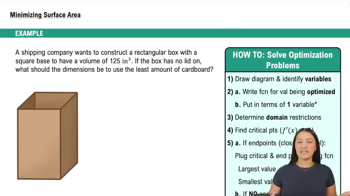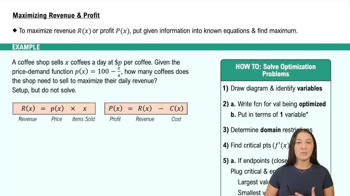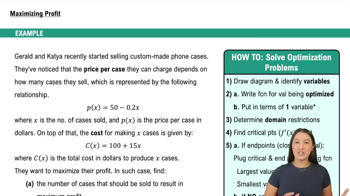Table of contents
- 0. Functions7h 52m
- Introduction to Functions16m
- Piecewise Functions10m
- Properties of Functions9m
- Common Functions1h 8m
- Transformations5m
- Combining Functions27m
- Exponent rules32m
- Exponential Functions28m
- Logarithmic Functions24m
- Properties of Logarithms34m
- Exponential & Logarithmic Equations35m
- Introduction to Trigonometric Functions38m
- Graphs of Trigonometric Functions44m
- Trigonometric Identities47m
- Inverse Trigonometric Functions48m
- 1. Limits and Continuity2h 2m
- 2. Intro to Derivatives1h 33m
- 3. Techniques of Differentiation3h 18m
- 4. Applications of Derivatives2h 38m
- 5. Graphical Applications of Derivatives6h 2m
- 6. Derivatives of Inverse, Exponential, & Logarithmic Functions2h 37m
- 7. Antiderivatives & Indefinite Integrals1h 26m
- 8. Definite Integrals4h 44m
- 9. Graphical Applications of Integrals2h 27m
- 10. Physics Applications of Integrals 2h 22m
5. Graphical Applications of Derivatives
Applied Optimization
Problem 4.R.41
Textbook Question
Maximum printable area A rectangular page in a text (with width x and length y) has an area of 98 in² , top and bottom margins set at 1 in, and left and right margins set at 1/2 in. The printable area of the page is the rectangle that lies within the margins. What are the dimensions of the page that maximize the printable area?
 Verified step by step guidance
Verified step by step guidance1
Define the dimensions of the page: Let the width of the page be x inches and the length be y inches. The total area of the page is given by the equation x * y = 98 square inches.
Determine the dimensions of the printable area: The printable width is (x - 1) inches, accounting for 1/2 inch margins on each side, and the printable length is (y - 2) inches, accounting for 1 inch margins at the top and bottom.
Express the printable area: The printable area A can be expressed as A = (x - 1) * (y - 2).
Substitute the constraint into the printable area equation: Since x * y = 98, express y in terms of x, y = 98/x, and substitute into the printable area equation to get A = (x - 1) * (98/x - 2).
Find the critical points: Differentiate the expression for A with respect to x, set the derivative equal to zero, and solve for x to find the critical points. Use the second derivative test to determine if the critical point is a maximum.
 Verified video answer for a similar problem:
Verified video answer for a similar problem:This video solution was recommended by our tutors as helpful for the problem above
Video duration:
6mPlay a video:
Was this helpful?
Key Concepts
Here are the essential concepts you must grasp in order to answer the question correctly.
Optimization
Optimization in calculus involves finding the maximum or minimum values of a function. In this context, we need to determine the dimensions of the page that maximize the printable area, which requires setting up a function that represents the area and then using techniques such as taking derivatives to find critical points.
Recommended video:

Intro to Applied Optimization: Maximizing Area
Area of a Rectangle
The area of a rectangle is calculated by multiplying its width (x) by its length (y). In this problem, the total area is constrained to 98 in², and we must account for the margins to find the effective dimensions that contribute to the printable area, which is the area available after subtracting the margins.
Recommended video:

Estimating the Area Under a Curve Using Left Endpoints
Constraints
Constraints are conditions that must be satisfied in an optimization problem. Here, the constraints include the fixed total area of 98 in² and the specific margin sizes, which limit the possible values of width and length. Understanding these constraints is crucial for correctly formulating the problem and finding the optimal solution.
Recommended video:

Intro to Applied Optimization: Maximizing Area

 1:13m
1:13mWatch next
Master Intro to Applied Optimization: Maximizing Area with a bite sized video explanation from Callie
Start learningRelated Videos
Related Practice








